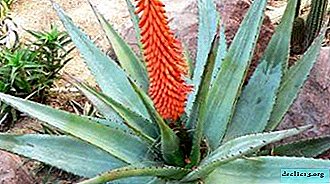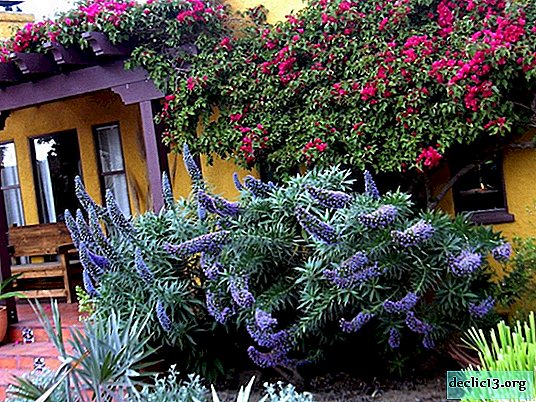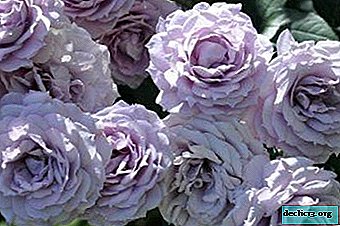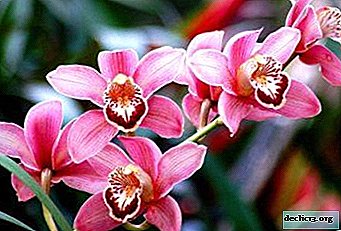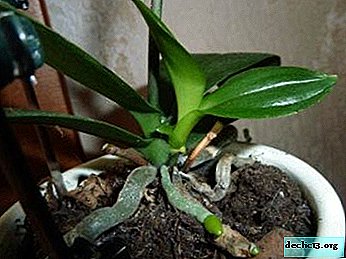Velvet luxury - all about rose Eddie Mitchell
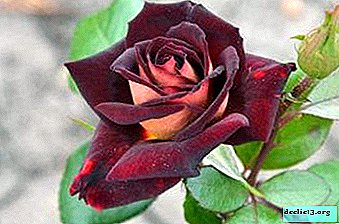
Rose is the most charming flower in the world. The perfection of nature was embodied in him. The beauty of a rose is capable of touching the thinnest strings of the soul. She delights, surprises, leaves a mark on the soul. That is why the French breeder created the magnificent rose Eddie Mitchell.
Using a flower of this color you can create an incredibly beautiful flowerbed, and a bouquet made with Eddie Mitchell will not leave anyone indifferent.
Description
Rose Eddy Mitchell is a variety of tea hybrid variety. It blooms with velvety flowers of extraordinary beauty, reminiscent in color of exquisite burgundy French wine. The outer side of the petals is painted in golden color, which gives the rose aristocracy. Thanks to the unusual contrasting color, the rose Eddie Mitchell became the queen of the gardensattracting admiring glances.
The flowers of the rose are quite large, very attractive, their size reaches 12 cm in diameter. On the stem, one to three flowers can be seen, exuding a light pleasant aroma. Rose bush 50-60 cm high, up to 40 cm wide, strewn with dense, dark green glossy foliage.At the very beginning of the flowering of the rose, the petals are perfectly folded in the shape of a glasswrapped in delicately curved lower petals. After some time, the middle of the flower becomes visible, the petals turn brown.
Photo
Further you can familiarize with a photo of a plant.



History of occurrence
The birthplace of Eddie Mitchell roses is France. She appeared in 2008 by crossing a tea and a repair rose.This stunningly beautiful flower was named after the wonderful French singer, songwriter and actor Eddie Mitchell.
Differences from other species
Flower Eddie Mitchell is very favorably with other types of roses. In addition to his extraordinary beauty, he tolerates rains, his flowers do not spoil. Winter-hardy plant, rarely susceptible to disease, harmoniously fits into any landscape design.
Bloom
Rose Eddie Mitchell is a re-flowering plant. It blooms profusely all summer and until mid-autumn. In the first year of a plant's life, it is undesirable for it to bloom early.
Better prune buds before August. Then leave only 2 flowers on the shoot, then next year the rose will delight you with a very lush flowering.
Annual abundant flowering can be achieved by cutting flowers until they finally wilted.
Use in landscape design
 Rosa Mitchell looks great even in the smallest garden. It can become the main chord in the flower garden or mixborder.
Rosa Mitchell looks great even in the smallest garden. It can become the main chord in the flower garden or mixborder.
This variety of roses will harmoniously fit into a variety of landscape styles:
- rural country;
- classic french;
- refined modernist style;
- English landscape.
Choosing a landing place
Rose Eddie Mitchell is so beautiful that it is better to plant her in places with a good view of the house to admire her. She does not like scorching sunlight, so the afternoon shadow is ideal for her. In the sun, the plant quickly fades due to burns on the petals.
Correctly selected planting site will help to maintain the health and attractive appearance of the rose. If the plant is provided with the correct air circulation, then it will not be affected by diseases and pests.In the lowlands, the flower will feel uncomfortable, from stagnant cold air and waterlogged soil, he can get sick and die.
What should be the soil?
Rosa needs fertile, breathable soil. Clay soil must be improved by adding sand, peat, humus and compost. Sandy soil is not suitable for the plant, so clay with humus is added to it. The rose feels best in a slightly acidic earth. Manure or peat are used to acidify insufficiently acidic soil. Ash is added to lower acidity.
Landing and temperature
 Eddie Mitchell planted a rose in the spring, most often in Aprilwhen the earth warms up to +10 degrees. To do this, dig a hole to a depth of about 60 cm and pour crushed stone, pebbles and gravel into it with a layer of 10 cm, then a layer of organic fertilizers. They pour earth on top. Before planting, it is recommended to keep seedlings in a solution of "Heteroauxin" so that the plant takes root faster.
Eddie Mitchell planted a rose in the spring, most often in Aprilwhen the earth warms up to +10 degrees. To do this, dig a hole to a depth of about 60 cm and pour crushed stone, pebbles and gravel into it with a layer of 10 cm, then a layer of organic fertilizers. They pour earth on top. Before planting, it is recommended to keep seedlings in a solution of "Heteroauxin" so that the plant takes root faster.
The seedling is lowered into the ground, and the root neck should go 3 cm into the soil, the roots are covered with earth. The flower must be immediately watered. The earth needs to be sprinkled if it has settled.
The plant tolerates low temperatures well, up to -23 degrees and refers to the 6th zone of winter stability.
Watering
Watering a rose is a must, especially when there is a drought. The bush requires about 15 liters of water at room temperature 2 times a week. By the end of the summer period, the plant is less and less in need of watering. In autumn, you don’t need to water it at all.
Top dressing
The choice of top dressing for roses depends on the season. In early spring, it is better to use complex fertilizers, which contain phosphorus, nitrogen and potassium. Nitrogen is necessary for the rose in the spring and summer, when there is an intensive growth of leaves and shoots. Phosphorus and potassium are important for the plant during the formation of the buds.
The last time you need to feed the flower in mid-September. From organic fertilizers, rotted manure is very suitable.Pruning
Pruning is done to form a beautiful bush., or in order to achieve a lush flowering rose. Produce it in the spring when the kidneys swell. Pruning happens:
- Weak (long). Represents the removal of faded parts. It is applied in the summer period.
- Strong (short). Only 2 to 4 buds are left on the shoots. It is performed in the spring after planting roses and to rejuvenate existing bushes.
- Medium (moderate). 5 to 7 buds are left on the shoots. Such pruning provides early profuse flowering. Spend her in the spring.
In the fall, you also need to trim to thin out the bushes and remove damaged shoots.
Preparation for winter
For the winter, roses need to be sheltered, but up to -7 degrees it is better not to do this so that the plant can adapt to winter. Before sheltering the flower you need to prepare: cut and spud at the base. Spud better garden soil, humus or compost.
Fir branches are ideal for sheltering roses. Then, above the plant at a height of 30 cm, a frame of wire or metal profile is installed, insulation and film are stretched. In spring, the flower must be aired. You can not allow a strong increase in temperature so that the kidneys do not go to growth ahead of time.
Breeding
 This type of roses propagated by cuttings. Cuttings occur as follows:
This type of roses propagated by cuttings. Cuttings occur as follows:
- Choose healthy shoots with a thickness of 5 mm.
- Cut the shoots with secateurs into segments (each should have 3 to 5 buds). The upper section should be 2 cm above the kidney, and the bottom under the lower kidney.
- Leaves from the bottom to completely remove.
- Before planting, treat the bottom cut with Epin.
- Plant cuttings in the ground and water.
Diseases and Pests
The flower is highly resistant to rose diseases such as powdery mildew and black spotting.In order to prevent it, it is still better to treat the bush with the systemic fungicide Fundazole or Topaz in early spring, and copper sulfate is also suitable.
Hybrid tea roses adore pests:
- pink earwig;
- spider mite;
- rose aphids and thrips.
To combat them, the insecticides Actellic and Inta-Vir are used.
Thanks to the proper care of the flower, the queen - a rose of Eddie Mitchell, an exquisite aristocrat with a delicate smell of French perfume will now bloom in your garden.

